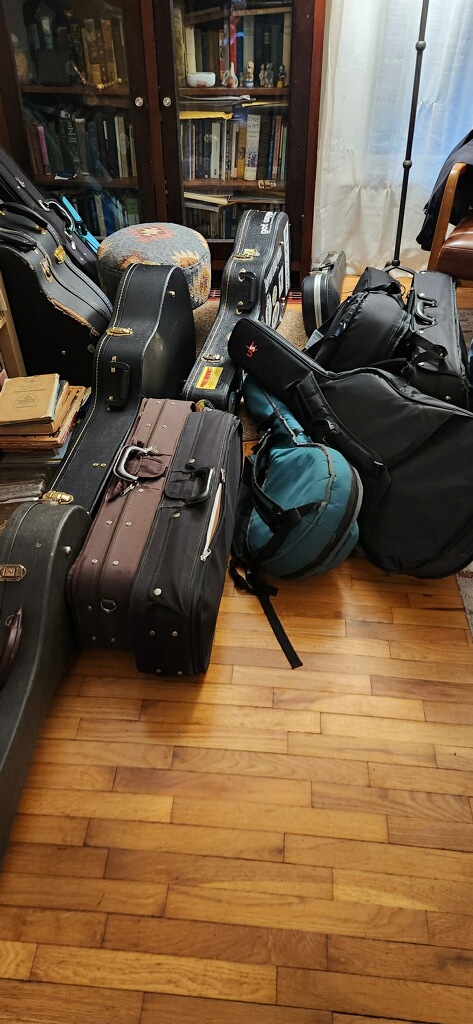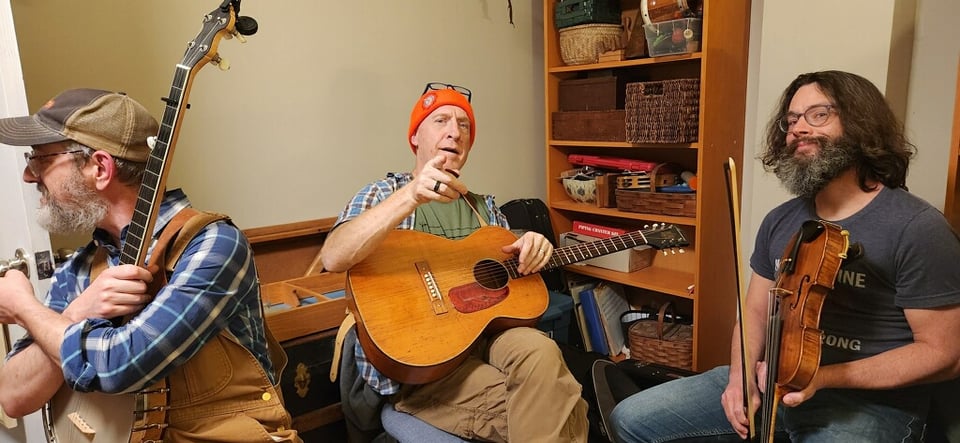The Circle is Home

It was cramped in the back room the other night at Brenda and Drew’s place - there were four or five fiddles, two or three banjos, two or three guitars, and half a dozen tapping feet besides at any given moment - and I had to adjust my bow arm between tunes so as not to bash the headstock on Phil’s guitar whilst playing. To be honest, it’s a little surprising that none of the mint julips they were serving that night ended up on the floor.
The sound of playing tunes with a roomful of folks is a marvelous thing. I imagine all the sound waves bouncing off the walls and just saturating the space. Early on in the night we were playing a tune - “Dry and Dusty” maybe? - that really brought out the droning quality in the music. Like, when I say we were in “D,” I mean we were really in D. It wasn’t just a set of notes and chords, but a (meta)physical place and we were there.
Thinking of the sound reminds me of Indian music. The Indian tradition developed more along the lines of rhythm, in contrast to the highly developed harmonic system of Western European music. In the US and Europe, we’re all accustomed to the equal temperament tuning system and the diatonic harmony that emerges from it, but in India tuning is done using the overtone series. It is conventional in old-time circles to stay in one key for a period of time, which sometimes feels to me like a vestige of older musical traditions. The tuning system we use didn’t come about until the 18th century, and my sense is that the predominance of keyboard instruments is what cemented the practice (because tuning a piano takes hours, and tuning an organ is pretty much a one-time thing). But with string band music, you can (maybe?) get the feel of the older, more organic system of tuning.
Theoretical considerations aside, playing tunes in “D” really wasn’t so much a specific repertoire as a place to hang out with friends. And over the course of the evening I heard folks voice that sentiment, that jamming together was a way of getting to our happy place, something we seem to need more than ever these days. Maybe a little bit like the house churches from early Christianity - the classic description being “…the believers were together and had everything in common.” (Acts 2:44). I think life in modern society can often be alienating, and community, though we come to it naturally enough, has to be actively cultivated. When people get together for the purpose of being together and experiencing something in common, they build community. It’s possible to exist in society without doing that, you know - you can interact with people exclusively through transactions, financial and otherwise, but it starves a person’s spirit to live that way.
The title of this piece comes from the first line of a poem by my friend Charlie Getter. Many moons ago, we were part of a group of poets and musicians who would get together on a street corner in San Francisco to perform for one another. The story of that scene deserves a piece of its own, but I want to mention a particular aspect of it here: in the early days of the street corner gathering, there were two camps, as it were. There were artists, people who were really into being creative, and there were activists, who were more interested in doing art as political action. Over time, the activists mostly disappeared from the scene, while the artists are still out there every Thursday night, more than twenty years later. What I take from that is that sustaining community - something we all need, but made difficult by modern life - requires having and doing things in common. Old-time music lends itself well to that sort of thing.
The jam I attended the other night was the first proper house jam I’ve been invited to, and I was very excited to be there. And it turns out I know some tunes! We went around the circle, the fiddlers (or sometimes the banjo) taking turns calling tunes, and when it came to me, I had tunes to play. The first tune I lead was “Decatur Reel,” I think. The first phrase resembles the melody of “I’m a Little Teapot,” which my three-year-old sings regularly, putting “Decatur” within convenient reach of my mind. Later in the night I had a memorable time playing “Paddy on the Turnpike,” a tune I learned because of a Lotus Dickey recording (although I didn’t learn his version). Drew, maker of many mint julips that evening, played a spirited mandolin accompaniment on that tune.
What surprised me was that I recognized many of the tunes that I don’t (yet) have memorized - “Tipping back the corn,” for example, is not a tune I’ve learned, but I’ve played it before, and my fingers seemed to recall it readily enough. It’s a funny thing about muscle memory: sometimes you’ll be playing, and its almost like your fingers are moving without having to be told where to go at all. I suppose that’s a natural consequence of spending time soaking in old-time tunes: there are certain common patterns and phrases, and after a while, you can just do them without having to think about it. And although it wasn’t my first experience with that sort of thing, it was probably the first time its happened to me playing old-time music.
At some point in the evening, while we were still in D, somebody said they were in the kitchen, where they could hear the jam in the front room in one ear and us in the back room in the other ear. The front room was in “G,” which is, harmonically speaking, pretty close to “D,” but having one key in each ear lead to some cognitive dissonance for the listener in the kitchen. It made me think of the great American composer Charles Ives, who, as a child, the story goes, would be made to play a hymn on the organ in one key while singing the same hymn in a different key, as a method of punishment, by his father. Ives later would build on those experiences by writing music with different keys, and sometimes different time signatures, played simultaneously, giving rise to wholly new sonic textures and make Ives widely influential in the 20th century American music.
There’s a kind of wild and wooly character to a house jam that is reminiscent of Ives for me. We’re playing tunes together, but also in our own particular way, in a kind of unruly harmony. I think American music is often like that: different characters coming together and falling apart, everyone going their own peculiar way, and yet the music hangs together, sometimes in spite of itself.
In another way, the house jam reminded me of the character of Charles Ives. Although today he is famous as a composer, his primary occupation in life was as an insurance company executive. During the week he lived and worked in Manhattan, retreating to his home in Danbury, Connecticut on the weekends to labor over his music. I’m pretty sure everyone at the jam that night was an amateur - that is, like Ives, we all have straight jobs during the week that likely require a certain level of conformity and compromise. But, in the context of community - unbound by the demands of professional life - we are free to be ourselves.
The main reason this house jam happened was because the people who live in the house - Brenda and Drew - made it happen. Besides being gracious hosts, they’re both strong players and also delightful people to hang out with. It is my impression they’ve been an integral part of the old-time scene in Champaign-Urbana for many years, although their network extends a good distance. People drove upwards of three hours to be at the jam that night!
But, alas, it turns out the other night’s gathering may have been the swan song for this particular house jam, as Drew and Brenda are reportedly downsizing their living situation this summer. I’m sure they’ll continue to bring people together though - Brenda mentioned that I might play with the group she organizes for the regular contradances they have in Urbana.
In the meantime, I’m feeling pretty inspired. I met a couple of people the other night who mentioned the need for jams farther north, in the direction of my own house. And I have a pretty good size porch.

Add a comment: